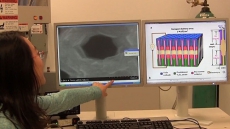You can soon watch your favourite 3D movie without headache or discomfort. A team of Russian researchers has found that apart from bad glasses and cheap projectors, certain 3D movies do have headache-provoking scenes which can be improved upon to give viewers a better experience.
A team of scientists led by Dmitry Vatolin, senior research fellow at Lomonosov Moscow State University, investigated the problem of headache provoked by 3D-movies for more than eight years.
This headache is a brain's reaction to the “wrong” images coming to both eyes simultaneously. The brain needs to combine them to produce a stereo effect, but unfortunately it does not always succeed.
Vatolin's research team names more than 15 reasons for that problem. These can be separated into two categories: imperfections of equipment and errors in the movie.
The first kind is explained by a natural desire of the distributors to lessen their expenses, which inevitably leads to a lower quality of the stereo show.
Bad glasses, cheap projectors and other tools of improper kind tend to worsen the quality of viewer's experience.
The reasons of the second category are more complicated, diverse, and unfortunately are not always detectable and preventable.
Among them, one of the most painful (and happily, one of the rarest to be seen) blunder is reordering of the left and the right views of the 3D video, that may sometimes happen even in the most professional production.
That is far from the only disadvantage of contemporary 3D-movies. As the main achievement of his team, Vatolin names a creation of “metrics” -- programmes allowing to track such errors, minimising the time of 3D movies technical control.
With the help of these metrics the research team scanned the present Blu-ray productions and compiled statistics of the main problems.
Nearly 105 Blu-ray discs were scanned using the metrics and more than 10,000 potentially problematic scenes were found.
In particular, 65 scenes with the left-right view swap were found in 23 different movies. Some problems were found even in such top ranking movies as “Avatar”, “The Chronicles of Narnia”, “Stalingrad”, etc.
“That means that the probability of buying a Blu-ray 3D movie with at least one scene with swapped left and right views is about 21 percent which is quite significant for sensitive people,' said Vatolin.
A lot of various errors were detected in horror movies, added Vatolin, which can be explained with their relatively low budgets.
“Right now looking for a good 3D quality you need to choose high-budget movies and properly equipped cinema halls. Wish you fewer headaches!” Vatolin noted.
A French portal issued a poll in 2011 on how people feel after watching 3D-movies.
It turned out that only one third of spectators have no trouble watching, while 27 percent feel “certain discomfort”, 22 percent complain about worsening condition, seven percent suffer terrible headache and the remaining 11 percent also notice a worsening state though due to some other reasons.
Vatolin believes that almost everyone who watched 3D-movies felt discomfort at least once, and many refuse watching 3D because of that problem they once had.
The results of the research were presented during the 27th annual “Stereoscopic Displays & Applications” conference in San-Francisco last month.




